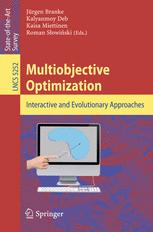

Most ebook files are in PDF format, so you can easily read them using various software such as Foxit Reader or directly on the Google Chrome browser.
Some ebook files are released by publishers in other formats such as .awz, .mobi, .epub, .fb2, etc. You may need to install specific software to read these formats on mobile/PC, such as Calibre.
Please read the tutorial at this link: https://ebookbell.com/faq
We offer FREE conversion to the popular formats you request; however, this may take some time. Therefore, right after payment, please email us, and we will try to provide the service as quickly as possible.
For some exceptional file formats or broken links (if any), please refrain from opening any disputes. Instead, email us first, and we will try to assist within a maximum of 6 hours.
EbookBell Team

0.0
0 reviewsMultiobjective optimization deals with solving problems having not only one, but multiple, often conflicting, criteria. Such problems can arise in practically every field of science, engineering and business, and the need for efficient and reliable solution methods is increasing. The task is challenging due to the fact that, instead of a single optimal solution, multiobjective optimization results in a number of solutions with different trade-offs among criteria, also known as Pareto optimal or efficient solutions. Hence, a decision maker is needed to provide additional preference information and to identify the most satisfactory solution. Depending on the paradigm used, such information may be introduced before, during, or after the optimization process. Clearly, research and application in multiobjective optimization involve expertise in optimization as well as in decision support.
This state-of-the-art survey originates from the International Seminar on Practical Approaches to Multiobjective Optimization, held in Dagstuhl Castle, Germany, in December 2006, which brought together leading experts from various contemporary multiobjective optimization fields, including evolutionary multiobjective optimization (EMO), multiple criteria decision making (MCDM) and multiple criteria decision aiding (MCDA).
This book gives a unique and detailed account of the current status of research and applications in the field of multiobjective optimization. It contains 16 chapters grouped in the following 5 thematic sections: Basics on Multiobjective Optimization; Recent Interactive and Preference-Based Approaches; Visualization of Solutions; Modelling, Implementation and Applications; and Quality Assessment, Learning, and Future Challenges.